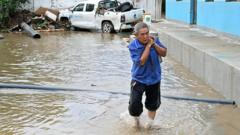In a tragic event that has left the community in shock, 31 residents of an elderly care home in the Miyun District on the outskirts of Beijing tragically perished as relentless flooding overwhelmed the facility. Local authorities have confirmed the deaths, attributing the high casualty count to the fact that many residents were immobile and unable to flee as the waters quickly rose to chest height. Emergency response teams were pictured battling through the deluge in attempts to rescue trapped individuals.
The catastrophic incident unfolded during a period marked by extreme weather across China, with a twin threat of severe heatwaves and unprecedented floods. Authorities have reported a total of 44 fatalities linked to the flood events in Beijing, signaling a worrying trend across the nation.
As the double-whammy of climate challenges unfolded, approximately 77 residents were present in the nursing home at the time of the flooding. Local media detailed that around 40 individuals were trapped when water levels surged to nearly 2 meters (6 feet). The home predominantly serves residents with severe disabilities and those from low-income backgrounds.
An official comment from a press conference reflected on the disaster, stating that the central area where the home is located was once deemed safe and thus excluded from evacuation plans. This oversight has prompted admissions of significant "loopholes in emergency planning," leading officials to advocate for more robust systems in the face of increasingly violent weather patterns.
In neighboring Hebei province, 16 fatalities have also been reported due to the intense rainfall, including eight deaths in the city of Chengde, with many others still unaccounted for. Beijing, which is historically prone to flooding during summer months, has faced its deadliest deluge since a 2012 incident that claimed 79 lives.
This current summer season has seen devastating weather events across various regions, including a prior typhoon that left two dead and resulted in ten missing in Shandong province. Furthermore, experts warn that climate change is intensifying the frequency and severity of such natural disasters, particularly posing risks to agriculture and residents' safety.
According to China’s emergency management ministry, the impact of natural disasters in the first half of this year has amounted to a staggering economic cost of 54.11 billion yuan ($7.5 billion), with more than 90% of these losses stemming from flooding incidents. The aching toll of these events continues to draw attention to the urgent needs for improvement in disaster preparedness and climate resilience across the country.




















